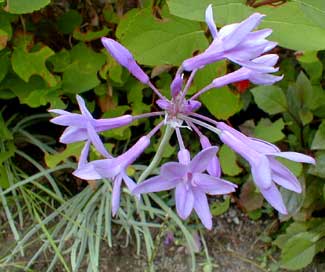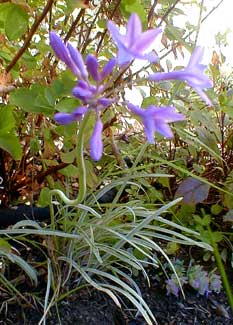 'Silver Lace'
'Silver Lace'
Society Garlic
"You haven't finished your ape, said mother to father. You didn't eat the hands, & I went to all the trouble to make onion rings for its fingers. I stuffed its nose with garlic, just like you like it."
-Russell Edson,
1976
1976
Tulbaghia violacea 'Variegata' or 'Silver Lace,' a native of South Africa, is similar to garlic, though only as a distant cousin. It is more closely related to narcissis. The first August photo shows both flower & the grassy foliage. The second photo is from late September.
In gardening books, dry sandy landscapes in full sun are often recommended for this perennial. But when we had a clump in a sunny dry area & two clumps in a sunny well-watered area, it did so much better with moisture that we moved the drier one to be with the others. I have seen it elsewhere doing very well in a bog garden with no drainage at all. My experience indicates it is not suited to xeriscape conditions but needs plenty of water except during winter dormancy. It won't die in droughty conditions but it won't bloom either.
It forms a semi-evergreen chives-like clump which grows to a foot or occasionally a bit higher, with the flower stems rising to two feet or occasionally higher. The variegated cultivar 'Silver Lace' has blue-green & cream-striped grassy leaves.
 The delicate lavender flowers have a very long season, blooming off & on from mid-spring until early autumn. In a protected sunny spot, they will bloom right up to November. It produces capsuled seeds, but is usually propagated by division of the corms from the bulbous roots. It takes a couple of years to develop from seeds.
The delicate lavender flowers have a very long season, blooming off & on from mid-spring until early autumn. In a protected sunny spot, they will bloom right up to November. It produces capsuled seeds, but is usually propagated by division of the corms from the bulbous roots. It takes a couple of years to develop from seeds.If obtained as corms these should be planted a foot apart in Autumn. Young rooted plants can be set out in Spring or later. Sometimes said to be suited only to USDA zones 9 and 10, & at risk if it experiences weather extremes, it grows well for us on Puget Sound, which is in Zone 8.
There are cultivars & hybrids that are more sensitive, but 'Silver Lace' is comparatively hardy. If it undergoes stress in our zone, the worst that happens is it waits to bloom later in the year. It can be fertilized thrice a year for maximum flowering.
The striped grass smells like a very mild garlic if knocked into even slightly or jostled by the wind. Sometimes this odor is not entirely pleasant, until one realizes it does smell more like food than flowers.
It was named Society Garlic by white settlers in the South African veldt, who believed it did not effect the breath as much as real garlic, & so was more appropriately used in meals for polite society. The leaves can be used in soups as a garlic substitute. Flowers are only mildly fragrant & can be used along with the stronger leaves raw in salads.
The garlicy odor of the leaves is said to repell insects, so that this plant could be placed around the base of shrubs susceptible to insect attack. I have some doubts it is really much of a repellant; pollinators at least are not offended by it. Note, too, that practically pressed up against the Society Garlic are the lower leaves of Spiraea densiflora & some leafcutter bees quite enjoyed snatching half-circles off leaf edges where practically brushed up against the Society Garlic. The 'Silver Lace' itself, of course, is rarely assaulted.
Taylor's Guide to Herbs says the Zulus grew it to repel snakes, though if it does so, that would have to be secondary to repelling rodents which the snakes would otherwise be hunting in the repel area.